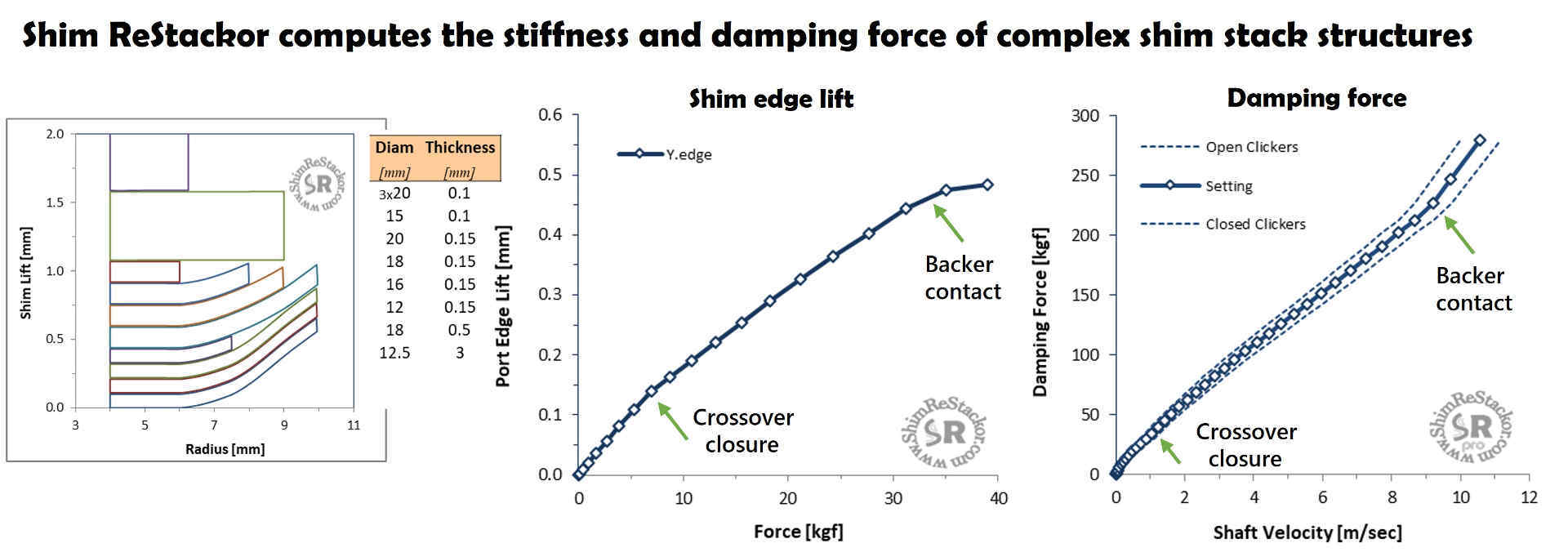Shock absorber performance is a multi-physics problem involving fluid dynamics, shim stack structural stiffness and dynamic response of the suspension system. Those are hard problems and must be solved simultaneously as a coupled system to obtain a physics based description of shock absorber performance.
Shim ReStackor solves those problems using thorough physics based analysis with simple inputs to produce practical results describing suspension performance across the entire range of bump velocities and suspension stroke depths.

Shim stack stiffness
- Stack stiffness
- Shim factors
Fluid dynamics
- Flow losses
- Oil properties
- Valve port design
- Ideal damping
Suspension response
- Response tuning
- Spring-mass-damper
- Link ratio
- Bump velocity
Shim stack stiffness
Shim ReStackor uses finite element analysis (FEA) to compute the stiffness of shim stack structures. The shim stack configuration is defined by a simple listing of shim diameters and thickness for each shim used in the shim stack.
Calculation outputs produce a snapshot of the deflected shim helping to ensure the calculation inputs match the intended shim stack configuration. The deflected stack snapshot also indicates crossover gap closure and potential high-speed stack contact with the shim stack backing washer.
Shim ReStackor outputs plot the face shim edge lift as a function of fluid force applied to the shim stack. Edge lift indicates the change in shim stack stiffness as crossover gaps close or limitations in stack deflection due to shim contact with the backing washer.
The damping force plot also indicates the tuning range of the clickers from closed to wide-open. The clicker tuning range provides a simple real-world reference quantifying potential shim stack modifications in terms of real-world forces you can actually “feel” when you ride.

Fluid dynamics
The flow resistance and pressure drop across the main piston creates the shock absorber damping force. The pressure drop also defines the fluid forces acting on the shim stack which drives the stack deflection. The flow area produced by the stack deflection ultimately defines the pressure drop itself. Damping force, stack stiffness, flow area and the valve pressure drop form a tightly coupled interactive system requiring simultaneous solution of all the components as a coupled system to obtain an accurate numerical description of shock absorber performance.
Clicker bleed circuits, valve port leak jets, valve port throat flow restrictions and port entrance restrictions are tunable features of the shock used to control shock absorber performance. Those features are modeled in Shim ReStackor using simple geometric measurements you can easily obtain in your garage. Parametric calculations help guide modification of the dimensions of those components to optimize shock absorber performance across the entire range of suspension bump velocities.

Suspension response
Suspension response calculations identify four targets tuning the suspension stiffness and setting the front/rear suspension “feel” and balance.
Equal spring force, equal bump travel and consistent rebound form a balanced response baseline setup. The suspension can be fine tuned from there.
- Equal spring force
- Equal front/rear crush under turning g-force
- Equal launch off bottoming stroke into rebound
- Rear shock rebound overshoot matches fork overshoot
- Fork rebound zeta 0.7 across stroke range
- Equal travel
- Fork compression damping matches rear shock with link ratio
- Riders prefer fork 20% stiffer on short strokes for handling

